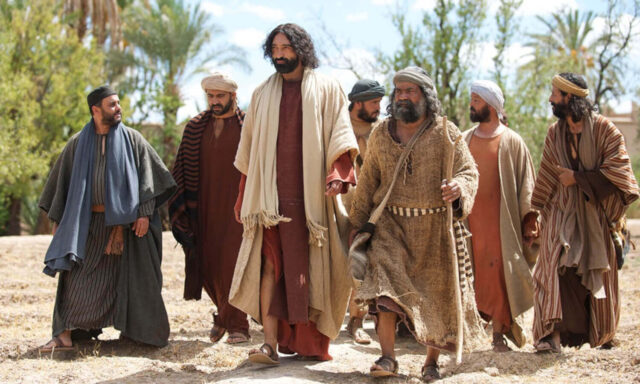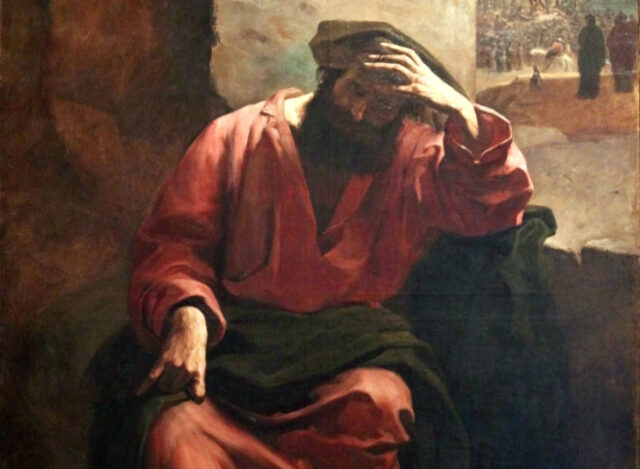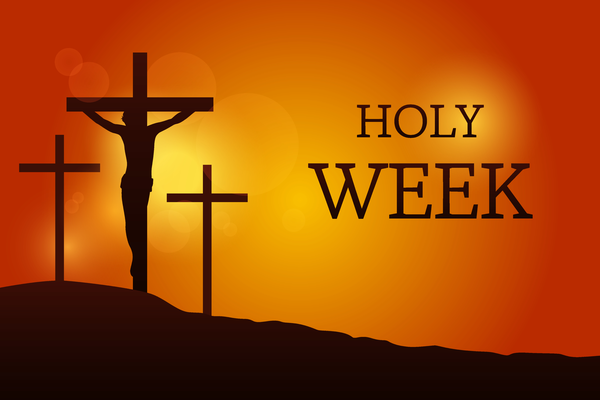
We’re all familiar with the idea that Lent is forty days long, and it used to be true that Lent involved forty days excluding Sundays, though this isn’t true now, given revisions to the Church’s liturgical calendar.
The length of Lent is inspired by the forty days that Jesus spent in the wilderness before he began his public ministry (Matt. 4:1-11, Mark 1:12-13, Luke 4:1-13).
However, there’s another forty days connected with Jesus, and we read about them at the beginning of Acts:
To them [the apostles] he presented himself alive after his passion by many proofs, appearing to them during forty days, and speaking of the kingdom of God (Acts 1:3).
Jesus then instructed the apostles to remain in Jerusalem until they received the Holy Spirit (Acts 1:4-5). This happened on Pentecost, fifty days after his Crucifixion on Passover.
These forty days are interesting in their own right, and many Christians have wondered about them. For example, why did Jesus only stay forty days and not the full fifty? Why leave when he did?
We aren’t told, but a likely explanation is that he was using the forty days as a parallel to his time in the wilderness. Just as he spent forty days in the desert to prepare for his ministry, he now stayed with the apostles for forty days, preparing them for their ministry.
The tradition that he remained with them forty days was not universal in the early Church, however. The second century Church Father Irenaeus of Lyons recorded that the Valentinian Gnostics claimed Jesus remained with the disciples for eighteen months (Against Heresies 1:3:2). The same view was held by another sect known as the Ophites (1:30:14).
Paulist Press’s translation of Irenaeus finds the origin of this counter tradition obscure. An editorial note on 1:30:14 says “How this strange error arose is a mystery,” and a note on 1:3:2 says, “Perhaps it was in some apocryphal work.”
Though the editors of the Paulist translation are unaware of it, this is actually the correct answer. There was an early noncanonical work that contained this tradition. The Ascension of Isaiah, which was written about the year A.D. 67, states:
And when he [Jesus] has plundered the angel of death, he will rise on the third day and will remain in that world for five hundred and forty-five days (Ascension of Isaiah 9:16).
Five hundred and forty-five days works out to just over eighteen months, and this may have been the origin of the Valentinian and Ophite believe that Jesus remained with the disciples for that amount of time.
Still, not all agreed. The third century Gnostic work called Pistis Sophia holds that Jesus remained with the disciples for an astonishing eleven years!
It came to pass, when Jesus had risen from the dead, that he passed eleven years discoursing with his disciples (Pistis Sophia 1:1).
However, the canonical book of Acts is divinely inspired, and Luke was an excellent historian, so we should go with him. Forty days it was.
What was Jesus doing in this time? According to various Gnostic sects, he was imparting their secret Gnostic teachings to the apostles.
According to their idea, Jesus gave two sets of teachings. The first was an exoteric or public set of teachings that the apostles passed down to the bishops to be shared with the faithful in general, and the second was an esoteric or secret set of teachings that were to be shared only with a select few (the Gnostics themselves).
This “two sets of teachings” idea was to justify how the Gnostics could have teachings coming from Jesus that were manifestly different than those preached by the bishops.
Because books were fantastically expensive in the ancient world (with a single copy of Matthew costing the equivalent of more than $2,000), the Gnostics didn’t bother writing Gospels in our sense—that is, documents that told the full story of Jesus.
Instead, they supplemented the canonical Gospels by writing documents that zoomed in on particular moments in Jesus’ life. An example is the second century Gospel of Mary, in which—after the Resurrection—Jesus gave “Mary” (likely Mary Magdalen) secret Gnostic teachings.
However, even secular scholars acknowledge that Gnostic documents are too late to contain accurate information about Jesus’ life and teachings.
We also do not have writings from the Church Fathers that are early enough to provide reliable information about the forty days. Acts 1:3 is barely mentioned in the orthodox Christian writings of the second and third centuries, and when it is mentioned, we aren’t given any new information about the period.
So once again, we’re back to the canonical works if we wish to obtain that.
At the beginning of Acts, Luke tells us that Jesus essentially did three things during the forty days: (1) “he presented himself alive after his passion,” (2) “by many proofs,” and (3) “speaking of the kingdom of God.”
He may well have done other things, too, like spending time with the disciples, sharing table fellowship with them, and even possibly celebrating the Eucharist. But these are the three things Luke tells us he did.
When it comes to presenting himself alive, Luke mentions only two events from this period in Acts. The first is the instruction to remain in Jerusalem until the apostles receive the Holy Spirit (Acts 1:4-5), and the second is the Ascension (Acts 1:6-11).
But Luke tells us more in his Gospel, indicating that Jesus appeared to the two disciples (one of whom was Cleopas) on the road to Emmaus (Luke 24:13-35), that he appeared to Peter (Luke 24:34), that he appeared to the apostles “and those who were with them” (Luke 24:36-49), and that he ascended before them (Luke 24:50-53).
We can expand on these appearances by consulting other canonical texts. Matthew records that Jesus also appeared to the women who discovered the empty tomb (Matt. 28:9-10) and that he appeared to the Eleven in Galilee, where he gave them the Great Commission (Matt. 28:16-20).
John reports that Jesus appeared to Mary Magdalen, in particular, on the morning of the Resurrection (John 20:11-17) and that he appeared to the other core disciples (less Thomas) later that day (John 20:19-23). He also appeared to the Twelve including Thomas a week later (John 20:26-29), and he later appeared to a group of seven disciples at the Sea of Galilee (John 21:1-22).
The longer ending of Mark confirms many of these appearances, including the one to Mary Magdalen (Mark 16:9), the one on the road to Emmaus (Mark 16:12), and another to the Eleven (Mark 16:14), as well as the giving of the Great Commission (Mark 16:15-18) and the Ascension (Mark 16:19).
We also have evidence from St. Paul, who records the same appearance to Peter that Luke mentioned (1 Cor. 15:5a) and a subsequent appearance to the Eleven (1 Cor. 15:5b).
Paul strikingly says that “Then he appeared to more than five hundred brethren at one time, most of whom are still alive, though some have fallen asleep” (1 Cor. 15:6)—that is, by the time 1 Corinthians was written around A.D. 53.
After this appearance to more than five hundred, Paul says, “Then he appeared to James, then to all the apostles” (1 Cor. 15:7)—indicating first an appearance to James “the brother of the Lord” and then another appearance to the Twelve (which would have, by this time, included Judas’s replacement, Matthias; see Acts 1:12-26).
Finally, Paul says, “Last of all, as to one untimely born, he appeared also to me” (1 Cor. 15:8). However, Luke indicates that this occurred long after the Ascension and thus after the forty days were over (Acts 9:1-19).
When it comes to the “many proofs” that Jesus was alive, Luke records two of them in his Gospel. The first is this:
[The Eleven and those who were with them] were startled and frightened and supposed that they saw a spirit. And he said to them, “Why are you troubled, and why do questionings rise in your hearts? See my hands and my feet, that it is I myself; handle me, and see; for a spirit has not flesh and bones as you see that I have.” And when he had said this he showed them his hands and his feet (Luke 24:37-40).
The second is:
And while they still disbelieved for joy, and wondered, he said to them, “Have you anything here to eat?” They gave him a piece of broiled fish, and he took it and ate before them (Luke 24:41-43).
John appears to record more detailed accounts of these same two proofs, elaborating that the first occurred when Jesus invited Thomas to touch the wounds in his hands and side (John 20:24-28) and when he appeared to seven disciples at the Sea of Galilee and ate charbroiled fish with them (John 21:9-14).
When it comes to “speaking of the kingdom of God,” we are not told specifically what Jesus said.
The Gnostics obviously had their own (completely unreliable) theories. However, a more secure basis is found in the canonical works that we have.
The kingdom of God is a prominent theme in the canonical Gospels, and we are told that the disciples did not understand things that he told them before the Resurrection, including what he meant when he predicted that he would die and rise again (Mark 9:30-32), as well as other matters (John 2:21-22).
However, on the road to Emmaus, “beginning with Moses and all the prophets, he interpreted to them in all the Scriptures the things concerning himself” (Luke 24:27). Similarly, when he spoke to the apostles and those with them:
Then he said to them, “These are my words which I spoke to you, while I was still with you, that everything written about me in the law of Moses and the prophets and the psalms must be fulfilled.” Then he opened their minds to understand the Scriptures, and said to them, “Thus it is written, that the Christ should suffer and on the third day rise from the dead, and that repentance and forgiveness of sins should be preached in his name to all nations, beginning from Jerusalem” (Luke 24:44-47).
It is thus likely that in this forty-day period, Jesus reviewed many of his previous teachings about the kingdom of God and helped the disciples understand them more fully.
Did Jesus do other things in this period? It is quite possible. Near the end of his Gospel, John tells us:
Now Jesus did many other signs in the presence of the disciples, which are not written in this book (John 20:30).
Some of those signs may have occurred in the forty-day period he spent with the disciples after his resurrection.
However, whether he did so and what these signs may have been, we are not told. We must therefore leave them as an Easter mystery.










